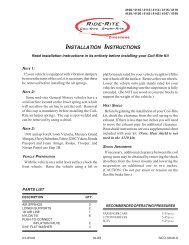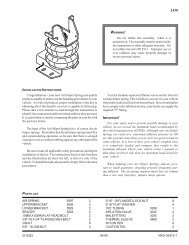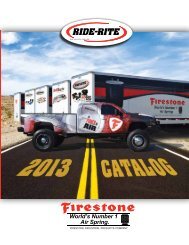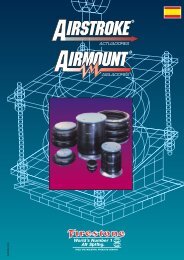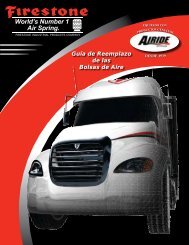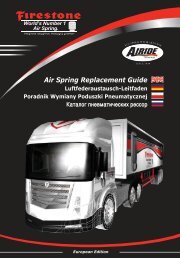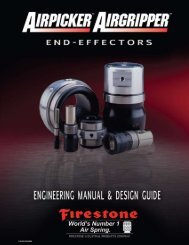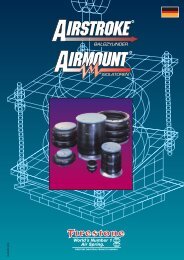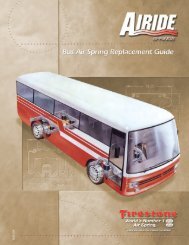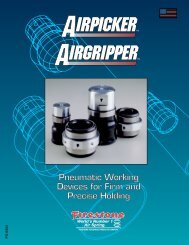Installation Instruction - Firestone
Installation Instruction - Firestone
Installation Instruction - Firestone
You also want an ePaper? Increase the reach of your titles
YUMPU automatically turns print PDFs into web optimized ePapers that Google loves.
The airline tubing should not be bent or curved sharply as it may buckle. Secure the airline tubing in place with<br />
the nylon ties provided. Push the end of the airline tubing into the inflation valve as illustrated see Figure “D”.<br />
STEP 6 - CHECK THE AIR SYSTEM<br />
Once the inflation valves are installed, inflate the air helper springs to 70 psi and check the fittings for air leaks.<br />
Using a spray bottle, apply a solution of soap and water to the fittings. If a leak is detected at an airline tubing<br />
connection then check to make sure that the airline tube is cut as square as possible and that it is pushed completely<br />
into the fitting. The airline tubing can easily be removed from the fittings by exhausting all the pressure in<br />
the air springs and then pushing the collar towards the body of the fitting and then, with a gentle pull, remove the<br />
airline tubing. If a leak is detected where the air<br />
fitting screws into the spring, deflate the air springs and remove the tubing, then screw the air fitting into the air<br />
spring one additional turn or until the leak stops. Reinstall the tubing and re-inflate the air springs and check for<br />
leaks as noted above. This now completes the installation. With a load on your vehicle and the air helper springs<br />
inflated, you must have at least 1/2" clearance around the air springs. As a general rule, the air helper springs will<br />
support approximately 50 lbs. of load for each 1 psi of inflation pressure (per pair). For example, 50 psi of<br />
inflation pressure will support a load of 2500 lbs. per pair of air helper springs. FOR BEST RIDE use only<br />
enough air pressure in the air helper springs to level the vehicle when viewed from the side (front to rear). This<br />
amount will vary depending on the load, location of load, condition of existing suspension and personal preference.<br />
NOTE: Too much air pressure in the air helper springs will result in a firmer ride, while too little air pressure will<br />
allow the air helper spring to bottom out over rough conditions. Too little air pressure will not provide the<br />
improvement in handling that is possible. TO PREVENT POSSIBLE DAMAGE MAINTAIN A MINI-<br />
MUM OF 5 psi IN THE AIR HELPER SPRINGS AT ALL TIMES.<br />
NOTE:<br />
MIN PRESSURE 5 PSI<br />
MAX PRESSURE (LOADED) 100 PSI<br />
NOTE:<br />
This kit was designed to work on vehicles with their original suspension. With the vehicle on the ground,<br />
unloaded, and 0 PSI in the air springs, the ride height of the air springs will be 5" to 6.5" tall.<br />
Should it become necessary to raise the vehicle by the frame, deflate both air helper springs completely.<br />
Reinflate the air springs after the vehicle is lowered to the ground.



